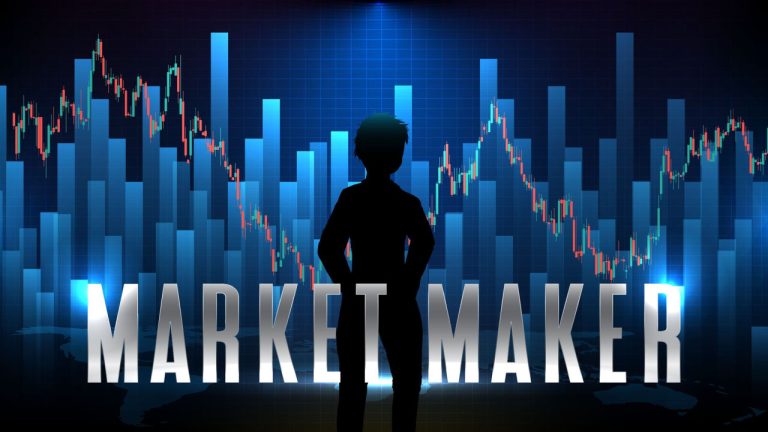
While the collapse of the crypto exchange FTX and its affiliate Alameda Research is thought to have left many crypto players, including market makers, in the worst possible position, according to Andrei Grachev, managing partner at DWF Labs, this incident may have helped to “flush out companies that were not sustainable enough to operate during a storm.” As a result, the “market will be healthier” going forward.
The Art of Market Making
Besides weeding out weak players, Andrei Grachev suggested in a written response to questions from Bitcoin.com News that the collapse of key crypto industry players like FTX and Terra has highlighted the importance of adopting measures that protect users. One such measure, which can be used by global digital asset market makers like DWF Labs, is the so-called pump-and-dump protection scheme. The scheme is essentially a liquidity management technique across exchanges.
Meanwhile, Grachev also shared his views on topics that range from the misconception about market makers to how market-making differs between centralized exchanges (CEXs) and decentralized exchanges. Below are the managing partner’s responses to the rest of the questions from Bitcoin.com News.
Bitcoin.com News (BCN): Can you briefly define market making as well as what happens when a user buys a crypto asset on a centralized exchange or sells this on a decentralized exchange?
Andrei Grachev (AG): A market maker creates liquid markets, quotes order books (puts buy and sell limit orders in order books) and maintains spread. In simple words – market makers create tradable markets. [Decentralized exchanges] DEXs (especially the automated market maker-based) are a bit more limited in terms of market-making tools, but even here – a market maker maintains a sufficient liquidity level across AMM [automated market maker] pools and does some additional work in order to maintain the same price level across centralized and decentralized exchanges.
Because market makers make money by spreading between the bid and ask prices, based on a given proposal, the market maker would [for instance] sell a token on Coinbase a few [basis] points (bps) higher than on a DEX and sell a token on the DEX a few bps cheaper than on Coinbase.
BCN: What would you say is the common misconception about market making?
AG: This is very close to a conspiracy theory: while a token goes up, the market maker is pumping; while a token is going down, the market maker is dumping. You know that situation when you bought something and then it went down instantly? The same. A market maker had a look at your position and traded against you.
The reality is completely different – a market maker maintains liquidity on both sides (buy and sell) and keeps a narrow spread. More advanced ones can also take limit orders from an order book in order to improve the market and boost organic volumes.
BCN: Does market making differ between decentralized exchanges and centralized exchanges?
AG: I would divide it a bit differently – order book based (it could be CEXes and DEXes) and other ones (only DEXes. It includes the AMMs on DEXes and concentrated liquidity on Uniswap V3).
Order books based exchanges allow market makers to use different order types (limit, Immediate-or-Cancel, market, etc.) in order to create a market and provide or take liquidity from the books.
AMMs are much less flexible because the trades happen in liquidity pools. The biggest challenge for AMMs is to maintain the same price on DEXes as their centralized counterparts by adding or removing liquidity as needed. They also constantly monitor large and predatory trades to mitigate their impact.
Concentrated liquidity is similar to AMM, but it allows traders and market makers to decide a price range for liquidity provision. It gives much more flexibility compared to AMM, but it’s still less flexible than the order book-based platforms.
Given that advanced market makers use their proprietary systems for operations, most of them, including DWF Labs, interact with DEXes via a virtual order book that is emulated based on blockchain transactions and the status of the AMM and concentrated liquidity pools.
BCN: How has the collapse of FTX and Alameda Research affected market makers and how is the market dealing with the crypto liquidity crisis? Also, are whales now wary of trading large volumes?
AG: First of all, all proper market makers had funds on FTX, because it was not possible to avoid trading on the second-largest exchange in the crypto world. Some of them were badly affected and collapsed. Many others are going through a rough financial situation now.
In general, it’s a very sad event, but it’s good for the long run. The market is flushing out companies that were not sustainable enough to operate during a storm. As a result, the market will be healthier.
Regarding whales and trading volumes, we observe a lot of activities on the over-the-counter (OTC) market as the exchange liquidity has declined dramatically since the crash. For example, the same tokens that used to see only [a] 10-12% price drop after a $500,000 sell order won’t even be able to absorb a $100,000 sell order now without the prices crashing 60-70%.
Fortunately, the market is recovering. We have begun to see this positive dynamic since the beginning of January 2023.
BCN: There is this notion among some project founders that liquidity is not a function of the market but of marketing. In fact, some founders believe that making sure there are enough buyers for sellers of their tokens is enough to solve their liquidity issues. How correct are these assertions?
AG: It’s true and not true simultaneously. Without marketing, liquidity is kind of inactive and artificial. If nobody trades or trades rarely, it would prompt a market maker to predict price deviations properly and they would need to increase the spread in order to maintain an acceptable risk level. That could lead to a death spiral – the spread gets worse and trading volume falls further, which results in an even worse spread.
In another scenario, let’s say a project relies entirely on organic traders. It’s possible – Bitcoin started without any market makers and it was fine. But it can be challenging to repeat this success.
Traders go to the market and have a wide range of tokens available for trading. If we are talking about a developing token – it would probably have a weak market structure even with good marketing. Why? Because compared to market makers, organic traders trade by their own vision instead of quantitative models. That makes spreads wider and execution speed slower because retail orders have to match against each other, instead of being bought and sold by a market maker instantly. For example, DWF Labs has a market share of 40-70% of trading volumes for many tokens and in case if we remove our configs from those markets, volumes would collapse.
BCN: Some market players have incorporated what is known as pump and dump protection. Can you briefly explain what this is all about and how market makers use this to ensure that the participants are safe in the event of extreme price volatility?
AG: If we exclude really dramatic events like FTX or Terra LUNA market crashes when the selling pressure was insane and nobody could help, we would see that market makers mitigate price actions by liquidity management across exchanges. In 99% of cases, pump or dump is executed on a particular exchange and then extended to other venues as a plague. If it’s not so dramatic, the plague could be prevented by fixing the price on the particular exchange. If it doesn’t work, market makers let the price discovery take place organically, and maintain a relevant market depth around the spread.
BCN: On the surface, market making seems like the smartphone industry where the products on offer are seemingly indistinguishable. How then do market makers differentiate themselves from the competition?
AG: [The] times market makers could offer just a simple bot to build an order book are gone. Market makers play an important role in the markets. We are not visible, but without us, the market would be much less efficient and spreads would be much wider.
I also believe that a proper market maker is also a proper partner, advisor and sometimes even investor that can leverage their knowledge and relationships with exchanges, funds and portfolio companies in order to push the project up and let it grow. DWF Labs builds relationships with projects only in this manner, acting not just as a market maker but also as a partner. As you said, it’s like the smartphone industry, but there is only one Apple even in the smartphone industry.
BCN: Many projects are often said to be wary of launching their tokens in a bear market. Is this true (and if so does this makes sense)?
AG: There are two sides to every coin. During a bull market, a project could raise at a massive valuation, get listed on exchanges with a large market cap, and be pumped further by the market. Most such projects come crashing down once the market turns bearish. It’s hard to survive and meet the expectations of investors, especially when the ground reality lags far behind.
Compared to bullish markets, bearish markets have some beauty. Yeah, it is true that it’s more complicated to raise funds and valuation is usually smaller. But when a project goes to an exchange with a small cap, it is highly likely to be pushed by the market and then stabilized. Then given the fact that the project went to the market when everything was selling at depressed valuations, the market can only reverse to a bullish mode – which will push the project up and give it additional chances to succeed.
What are your thoughts on this story? Let us know what you think in the comments section below.
















